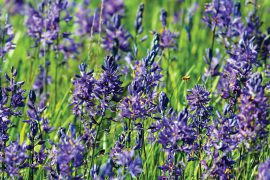 The community is invited to learn more and celebrate one of the area’s unique wildflowers – the camas – at the inaugural Camas Festival held from 10 a.m. to 2 p.m. Friday, May 6 on the Linfield University McMinnville Campus. The festival is a collaborative project of the Confederated Tribes of the Grand Ronde, Linfield University and Greater Yamhill Watershed Council (GYWC).
The community is invited to learn more and celebrate one of the area’s unique wildflowers – the camas – at the inaugural Camas Festival held from 10 a.m. to 2 p.m. Friday, May 6 on the Linfield University McMinnville Campus. The festival is a collaborative project of the Confederated Tribes of the Grand Ronde, Linfield University and Greater Yamhill Watershed Council (GYWC).
Tours of camas growth in the Cozine Creek area start from Linfield’s Oak Grove, located on the northwest corner of the university’s campus. Booths at the festival will include artifact displays and information about the history of camas in tribal traditions and foodways.
“This event will honor the living legacy of the Kalapuya through activities and engagement that center on one of our most important foods,” said David Harrelson (Kalapuya), Grand Ronde Tribes cultural resources manager.
Plans to create the festival began in November 2020 when the university began investigating a new name for a two-block street on the McMinnville campus. The search led the university to the Confederated Tribes of the Grand Ronde, and together, the groups chose Lakamas Lane. Lakamas is the word for camas in the Chinuk Wawa language. Plans soon developed to celebrate camas, which grows in large numbers t on campus.
“The Camas Festival and partnership with the Confederated Tribes of the Grand Ronde is a manifestation of Linfield’s mission to connect learning, life, and community in important and meaningful ways,” said Bill Fleeger, a visiting senior scholar in the Linfield environmental studies department. “We are proud to showcase to the work that students studying environmental studies have done over the past six years to help restore and expand the population of camas, and other native species, in the Cozine Creek natural area on campus.”
In 2016, members of the GYWC began working with Linfield students to rid the Cozine Creek area of invasive species. In 2018, the project received a grant from the Oregon Watershed Enhancement Board Small Grant to fund weed control and planting. In the past two years, clearing has continued. and the project is in a maintenance phase that will last until 2024.
“The presence of the camas there was long-known, but the abundance now is a result of controlling weeds and removing competition for sunlight as that the existing bulbs could flower and existing seed in soil could grow, said Luke Westphal, executive director of the GYWC. “You would expect it to be affected by development, but this area is fairly undisturbed in terms of development.”
Camas bulbs are harvested April through early June when the flowers or dried flower petals are visible. They can be boiled, baked or slow roasted. When cooked for a shorter time, camas is fairly tasteless. When slow roasted for 24-48 hours, it becomes dark-colored and sweet. Before sugar was introduced, roasted camas was used to sweeten other foods. Cooked bulbs were made into cakes and dried for later use. Fresh bulbs can also be dried or frozen, and then used later in soups. Read more about camas on the American Indian Health and Diet Project site.
A limited amount of camas seed will be available for attendees to take home from the event. All involved are hoping the festival becomes an annual event.

